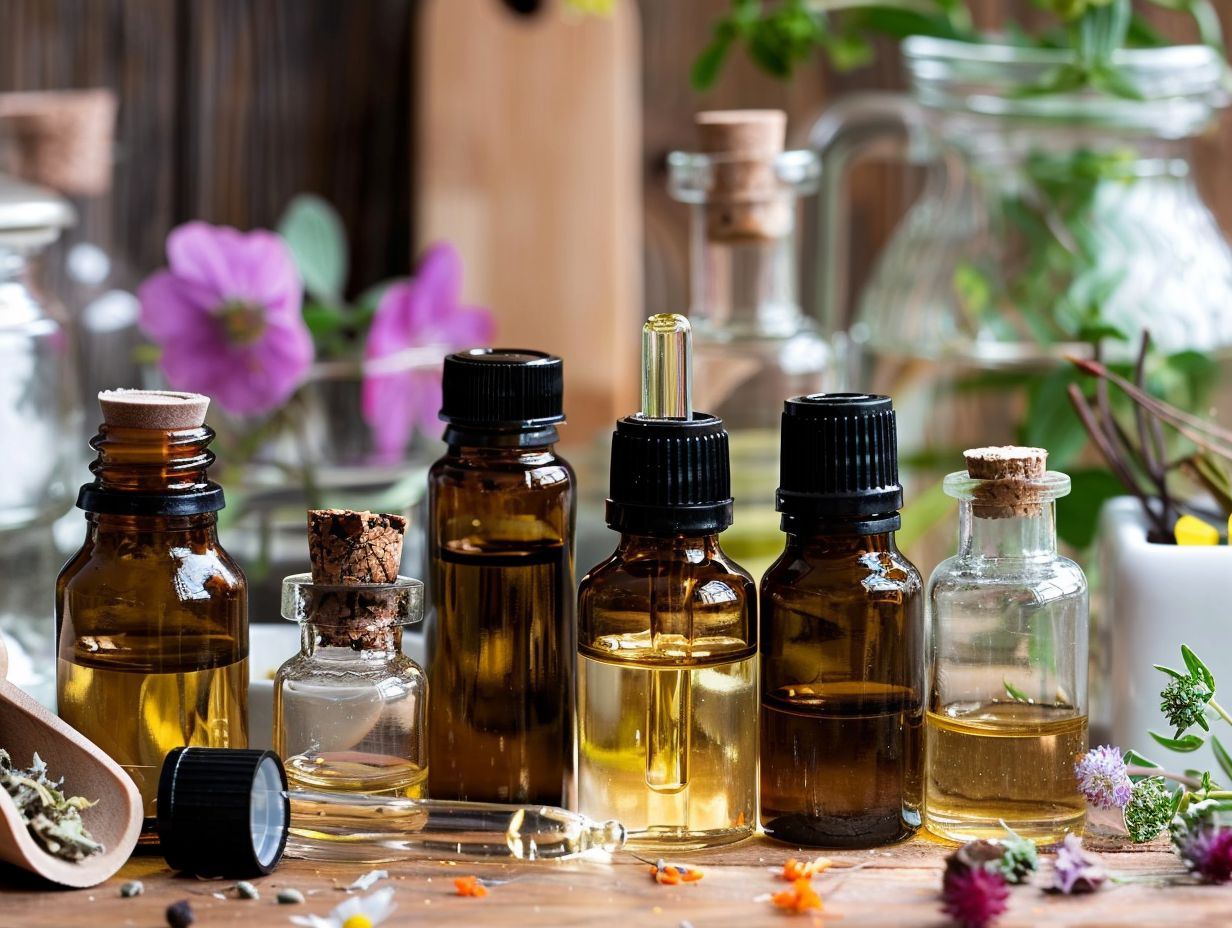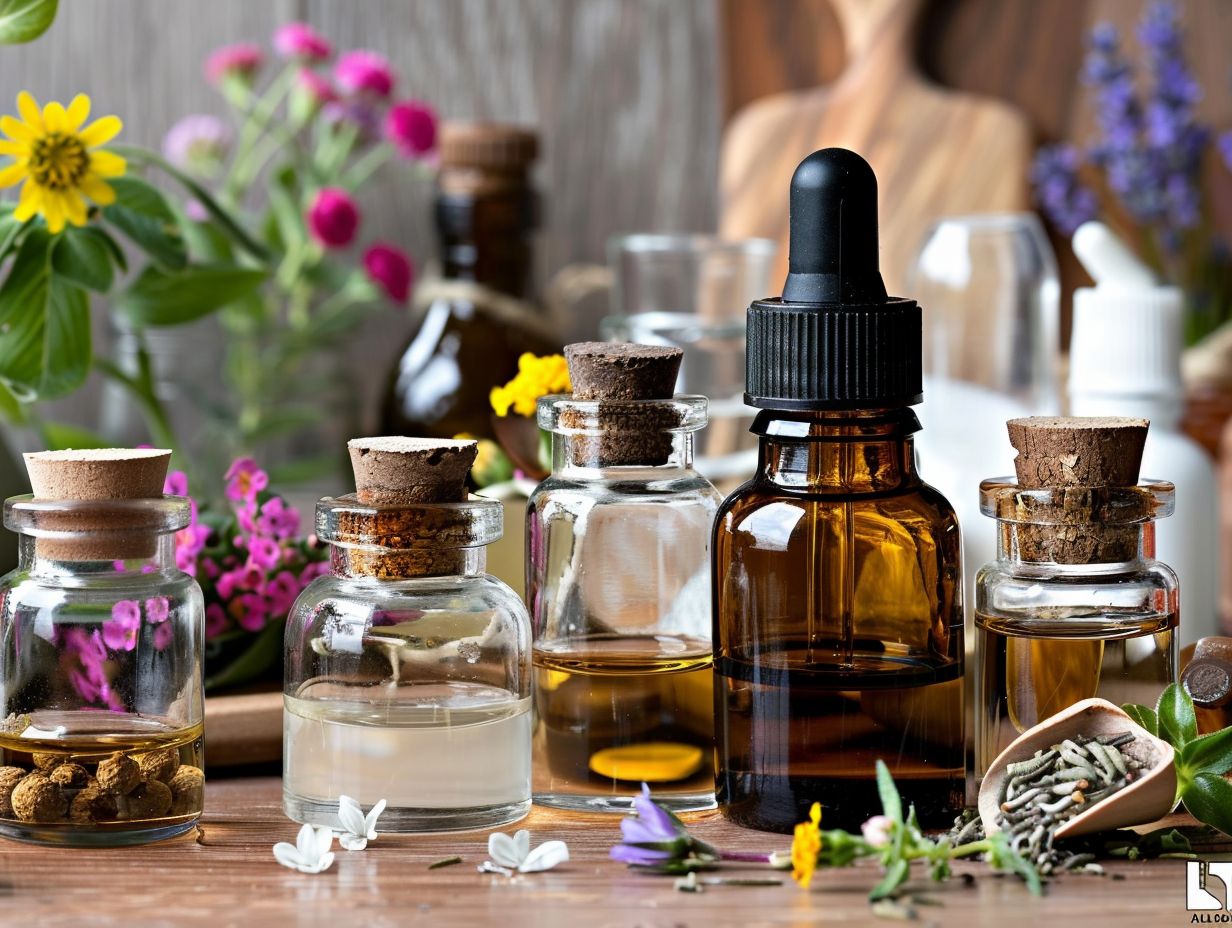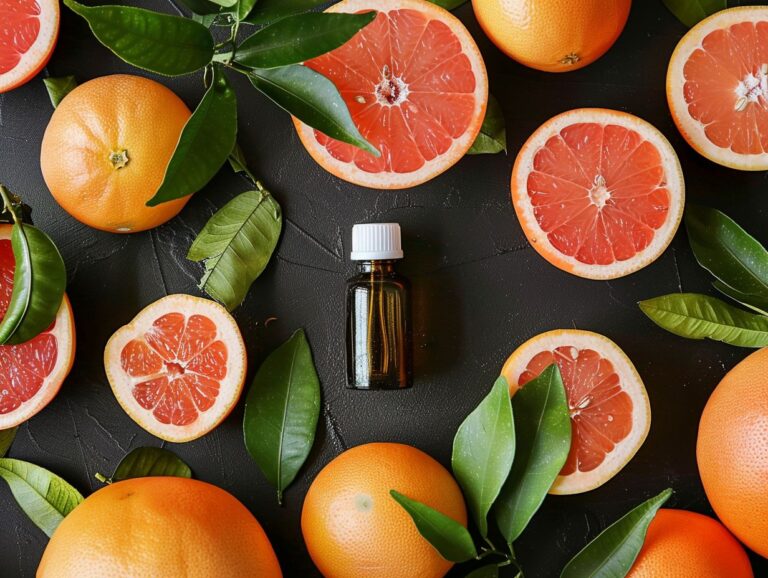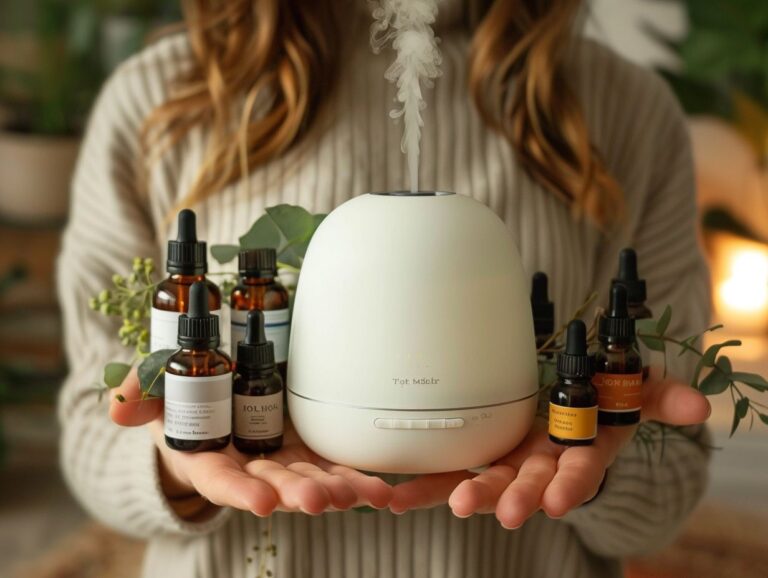Is Aromatherapy Oil Natural
Have you ever wondered about the magic behind natural essential oils? From how they are made to the benefits they offer, there’s a lot to discover.
In this article, we will explore the different types of aromatherapy oils, their benefits, and how to choose high-quality ones. We will also discuss the risks and side effects associated with using aromatherapy oils, as well as safety tips for their usage.
So, sit back, relax, and let’s dive into the world of aromatherapy oils!
Key Takeaways:
What is Aromatherapy Oil?
Aromatherapy oil, also known as essential oil, is a concentrated liquid containing aromatic compounds extracted from plants, offering various health benefits. These oils are used in aromatherapy to promote physical, psychological, and spiritual well-being through their therapeutic effects.
Essential oils are procured through methods like distillation, expression, or solvent extraction, ensuring the preservation of the plant’s natural fragrance and properties. The holistic approach of aromatherapy focuses on the overall well-being, considering the interconnectedness of the mind, body, and spirit. These oils can be inhaled, applied topically, or ingested, each method offering different benefits. From alleviating stress and anxiety to aiding in relaxation and sleep, essential oils have a wide range of applications in aromatherapy, skincare, massage therapy, and even home cleaning products.
How is Aromatherapy Oil Made?
Aromatherapy oils are typically made through processes like steam distillation, where plant materials such as lavender, tea tree, peppermint, and ylang-ylang are heated to release their aromatic compounds. This method ensures the retention of the oils’ quality and therapeutic compounds.
Steam distillation is a widely used method in the aromatherapy industry due to its effectiveness in extracting essential oils from plants. During the process, water is heated, producing steam that passes through the plant material, carrying its aromatic molecules. The steam then condenses, separating into water and the concentrated essential oil. Maintaining the purity and quality of these oils is crucial to preserve their therapeutic benefits and aromatic properties. Quality control measures such as proper storage, handling, and testing are essential to ensure the oils’ efficacy.
What are the Benefits of Aromatherapy Oil?
Aromatherapy oils offer a wide range of benefits, including reducing stress and anxiety, improving sleep quality, alleviating pain and inflammation, and boosting the immune system. These oils provide holistic solutions for enhancing physical, psychological, and spiritual well-being.
The therapeutic effects of aromatherapy oils extend to supporting respiratory health, enhancing cognitive function, and aiding digestion. Different essential oils have varying properties, such as relaxing, invigorating, or balancing effects, which can be tailored to meet specific needs. The use of these oils in aromatherapy not only impacts the body but also influences the mind and emotions, creating a harmonious balance within the individual. Employing a holistic approach, aromatherapy aims to address the root causes of imbalances, promoting overall wellness and vitality.
Reduces Stress and Anxiety
Aromatherapy oils such as lavender and ylang-ylang are known for their calming and relaxing effects, making them effective in reducing stress and anxiety levels. The soothing fragrance of these oils can promote relaxation and improve mental well-being.
These essential oils work by interacting with the olfactory system, sending signals to the brain that can help reduce feelings of tension and promote a sense of calmness.
- Lavender oil is popular for its ability to induce relaxation, ease insomnia, and uplift mood. It is often used in diffusers or added to bathwater for a soothing experience.
- Ylang-ylang oil, with its sweet floral scent, is known to help reduce stress and anxiety, while also balancing emotions and enhancing overall well-being.
Other recommended oils for relaxation include chamomile and sandalwood, both of which have sedative properties that can aid in calming the mind and body.
Improves Sleep Quality
Certain aromatherapy oils like lavender have therapeutic effects that can improve sleep quality by promoting relaxation and creating a conducive environment for rest. These oils aid in enhancing overall well-being by inducing a sense of calmness before bedtime.
Oils such as chamomile and ylang ylang are known for their sedative properties, which help in reducing anxiety and stress levels, two common culprits of poor sleep. These oils can be diffused in the bedroom or added to a relaxing bath to further enhance their soothing effects. The inhalation of sandalwood oil can stimulate a sense of inner peace and tranquility, helping the mind and body unwind after a long day.
Alleviates Pain and Inflammation
Aromatherapy oils like peppermint and tea tree possess anti-inflammatory properties that help alleviate pain and reduce inflammation. These oils contain therapeutic compounds that target specific issues, providing natural relief from discomfort.
Peppermint oil, for example, contains menthol, which acts as a natural analgesic, helping to numb and soothe sore muscles. Tea tree oil, on the other hand, boasts anti-inflammatory and antimicrobial properties due to its high levels of terpinen-4-ol. This compound helps to reduce swelling and fight off infections, making it a versatile remedy for various skin ailments.
Boosts Immune System
Aromatherapy oils with antibacterial and antimicrobial properties, such as tea tree oil, can boost the immune system by fighting off harmful pathogens. These oils support the body’s natural defenses and promote overall health.
Essential oils like eucalyptus and lavender have been found to possess potent antibacterial and antimicrobial qualities. When inhaled or applied topically, these oils can aid in strengthening the immune response by inhibiting the growth of bacteria and viruses.
Incorporating aromatherapy into your daily routine through diffusers, massage oils, or bath blends can provide a holistic approach to maintaining a healthy immune system. The soothing scents of these oils not only uplift the mood but also work internally to fortify the body’s defenses.
What are the Different Types of Aromatherapy Oil?

Essential oils are the pure essence extracted from plants through methods like distillation or cold pressing. These oils are highly concentrated and potent, often used in small amounts due to their strength. Each essential oil carries unique therapeutic properties, offering benefits like relaxation, rejuvenation, or even antibacterial effects.
Carrier oils, on the other hand, are neutral base oils that help dilute essential oils for safe application on the skin. Common carrier oils include coconut, jojoba, and sweet almond oil. They provide the necessary medium for essential oils to be massaged or applied evenly.
Infused oils go a step further by infusing plant material into a carrier oil, creating a synergistic blend. These oils can target specific concerns such as inflammation, pain relief, or skin nourishment, depending on the plants used in the infusion process.
Essential Oils
Essential oils like lavender and peppermint are considered therapeutic grade oils that offer high-quality and pure products for aromatherapy practices. The chemical composition of essential oils determines their effectiveness and benefits.
In terms of aromatherapy, the quality of the essential oils used is paramount. Therapeutic-grade oils are sourced from plants grown in optimal conditions and extracted using methods that preserve their natural properties. These oils are free from synthetic additives and fillers, ensuring a pure and potent product for use in various wellness practices.
The chemical composition of essential oils plays a crucial role in their therapeutic effects. Each oil contains a unique combination of volatile compounds that interact with the body and mind when inhaled or applied topically. For example, the presence of linalool in lavender oil contributes to its calming and relaxing properties, while the menthol in peppermint oil provides a refreshing and invigorating sensation.
Carrier Oils
Carrier oils are used to dilute essential oils for safe application, especially for individuals with sensitivities. Conducting a patch test with carrier oils helps determine any adverse reactions before full use.
Carrier oils play a crucial role in aromatherapy by aiding in the absorption of essential oils into the skin, enhancing their therapeutic benefits. For sensitive individuals, choosing the right carrier oil is key to avoiding any potential skin irritations or allergic reactions. Some popular carrier oils include jojoba, sweet almond, and coconut oil, each offering unique properties and benefits.
Infused Oils
Infused oils combine plant extracts with carrier oils, offering specific benefits but may contain potential allergens. Skin sensitization could occur with infused oils, making it essential to be cautious when using them in aromatherapy.
These oils are created by macerating herbs, flowers, or other plant materials in carrier oils like olive or coconut oil, allowing the beneficial properties of the plants to infuse into the carrier. Infused oils can be used topically for various purposes, such as skincare, massage, or hair treatments, offering a more natural alternative to commercial products.
Is Aromatherapy Oil Natural?
Aromatherapy oils are derived from natural sources like plants and herbs, making them natural remedies for various health concerns. Certain safety concerns, such as allergic reactions, should be considered when using these oils.
Ancient civilizations, including the Egyptians, Greeks, and Chinese, have used essential oils for their therapeutic properties for thousands of years. The process of extracting these oils involves steam distillation or cold pressing the plant material, preserving the natural essences.Essential oils are highly concentrated and should be used with caution to prevent adverse reactions. Individuals with sensitivities or allergies should perform a patch test before applying the oil directly to the skin. Always dilute essential oils with a carrier oil to reduce the risk of skin irritation.
What is the Difference between Natural and Synthetic Aromatherapy Oils?
The main difference between natural and synthetic aromatherapy oils lies in their composition and origin. Natural oils are derived from plant sources and offer holistic benefits, while synthetic oils are chemically produced to mimic natural scents without the same therapeutic properties.
One of the key distinctions between these types of oils is the chemical makeup. Natural oils contain complex chemical constituents that are naturally occurring in plants, which contribute to their therapeutic effects. On the other hand, synthetic oils are made of artificial compounds, lacking the intricate blend of beneficial components found in natural oils.
In terms of aromatherapy, the source of the oil plays a crucial role in its effectiveness. Natural oils not only provide aromatic benefits but also carry the essence of the plant they are derived from, offering a more authentic and potent experience. This authenticity is what allows natural oils to have a more profound impact on holistic well-being compared to their synthetic counterparts.
How to Choose High-Quality Aromatherapy Oil?
Selecting high-quality aromatherapy oils involves considering factors like purity certifications, ingredients lists, scent evaluation, and color assessment to ensure the safety and efficacy of the products. Opting for pure and quality essential oils is crucial for reaping the full benefits of aromatherapy.
When looking for premium aromatherapy oils, it’s essential to check for accreditation from reputable organizations like the International Organization for Standardization (ISO) or Ecocert, indicating adherence to strict quality standards.
Transparency in ingredient sourcing is key. Choose products that clearly state their origins and extraction methods, ensuring you know exactly what you are exposing your body to during aromatherapy sessions.
Don’t underestimate the power of your sense of smell. Conduct sensory evaluations to assess the aroma’s strength, complexity, and overall appeal before making a purchase.
Look for Purity and Quality Certifications
When selecting aromatherapy oils, prioritize those with purity and quality certifications, such as therapeutic grade designations, to ensure the oils are of high quality and free from contaminants.
These certifications serve as a seal of approval, indicating that the oils have undergone rigorous testing and meet specific criteria to be deemed safe and effective for therapeutic use.
Therapeutic grade standards are particularly crucial as they ensure that the oils maintain their natural properties and are potent enough to deliver the desired therapeutic benefits. Without proper certifications, there is a risk of using diluted or adulterated oils, which can be ineffective or even harmful. It is advisable to look for oils with recognized certifications from reputable organizations, such as the National Association for Holistic Aromatherapy (NAHA) or the Alliance of International Aromatherapists (AIA), to guarantee their authenticity and quality.
Check the Ingredients List

Reviewing the ingredients list of aromatherapy oils is essential to verify the use of natural products and understand the chemical composition of the oils. Transparent ingredient lists ensure that consumers are aware of what they are using for aromatherapy practices.
By examining the contents of aromatherapy oils, users can ensure they are harnessing the pure essence of plants instead of synthetic or artificial additives. Opting for natural components not only enhances the therapeutic benefits but also reduces the risk of adverse reactions commonly associated with synthetic fragrances.
Understanding the chemical composition allows individuals to make informed decisions based on their specific needs and preferences, tailoring their aromatherapy experience to suit their well-being. This knowledge enables individuals to choose blends that resonate with their body and mind, promoting a harmonious and personalized approach to relaxation and healing.
Consider the Scent and Color
The scent and color of aromatherapy oils can indicate their purity and quality, with natural oils typically having distinct fragrances and colors derived from their plant sources. Evaluating these sensory aspects can help in selecting authentic and effective oils.
In terms of aromatherapy, the intricate connection between scent and color goes beyond mere aesthetics. Each essential oil boasts a unique composition, resulting in a specific aroma and hue that provide valuable clues about its origin and properties. For instance, the rich amber hue of sandalwood oil hints at its grounding and calming qualities, while the fresh, citrus scent of lemon oil signifies its uplifting and clarifying benefits. By paying attention to these natural cues, consumers can make informed choices and ensure they are investing in high-quality products that align with their specific wellness needs.
Are There Any Risks or Side Effects of Aromatherapy Oil?
While aromatherapy oils offer numerous benefits, there are potential risks and side effects to consider, such as skin irritation, allergic reactions, and sensitivity to sunlight. Allergic contact dermatitis is a common concern for sensitized individuals.
It is crucial for individuals using aromatherapy oils to perform a patch test before widespread application to identify any possible allergic reactions. Some essential oils can cause photosensitivity, leading to skin irritation and damage when exposed to sunlight. Ensuring proper dilution of oils and following recommended guidelines on usage can significantly reduce the chances of adverse effects. It’s advisable to consult with a healthcare professional or aromatherapist before integrating new oils into your routine, especially if you have a history of skin sensitivities.
Skin Irritation
Skin irritation can occur when using aromatherapy oils due to their potent nature and potential inflammatory effects.
These reactions can range from mild discomfort to severe inflammation, causing itching, burning sensation, or even blistering of the skin. Certain essential oils like lemon or bergamot are known to be phototoxic, meaning they can make the skin more sensitive to sunlight, leading to burns or pigmentation changes.
It is crucial to ensure proper dilution of essential oils before applying them topically to reduce the risk of irritation. Patch testing on a small area of skin is also recommended to check for any adverse reactions or allergies. Always consult a qualified aromatherapist or skincare professional for guidance on choosing oils that are safe and compatible with your skin.
Allergic Reactions
Allergic reactions to aromatherapy oils can manifest as delayed hypersensitivity reactions, leading to conditions like allergic contact dermatitis. Patch testing is recommended for individuals to identify any sensitivities before extensive use.
Delayed hypersensitivity reactions can occur when the immune system reacts to a specific substance upon repeated exposure, causing symptoms like redness, itching, and swelling. Patch testing involves applying small amounts of the oils onto the skin to monitor any adverse reactions over a period of time.
It is crucial for individuals, especially those with sensitive skin or a history of allergies, to perform patch tests before incorporating new essential oils into their skincare or aromatherapy routine.
Diluting oils and avoiding direct contact with the skin can help reduce the risk of allergic reactions, ensuring a safe and enjoyable experience with aromatherapy.”
Sensitivity to Sunlight
Some aromatherapy oils can cause photosensitivity, making the skin more sensitive to sunlight and increasing the risk of sunburn or skin damage. It is crucial to be aware of oils that have this effect and take necessary precautions when using them.
When certain essential oils are applied to the skin, they can lead to a reaction known as photosensitivity, which heightens the skin’s vulnerability to the sun’s harmful UV rays. This reaction can result in severe sunburn or long-term damage, such as premature aging or an increased risk of skin cancer. Citrus oils like bergamot, lemon, and lime are commonly associated with photosensitivity. To safeguard your skin, it is advisable to avoid applying these oils topically before heading out in the sun. It is recommended to dilute essential oils properly with a carrier oil and conduct a patch test before widespread application to minimize the risk of adverse reactions.
How Should Aromatherapy Oil be Used Safely?
Ensuring the safe use of aromatherapy oils involves diluting them with carrier oils, conducting patch tests to check for skin sensitivities, and following proper usage guidelines to prevent adverse reactions. Safety measures are crucial for enjoying the benefits of aromatherapy without risks.
When diluting essential oils, a general rule of thumb is to use about 1-2% concentration for adults, which translates to about 3-6 drops of essential oil per ounce of carrier oil. Examples of carrier oils include sweet almond, jojoba, or coconut oil.
Before applying any essential oil topically, it is recommended to perform a patch test. Simply dilute a small amount of the essential oil and apply it to a small area of skin to check for any adverse reactions like redness, itching, or irritation.
Responsible application of aromatherapy oils also includes guidelines on safe inhalation and diffusion techniques. For instance, avoid direct inhalation of undiluted essential oils and ensure proper ventilation when diffusing oils in a room.
Dilute with a Carrier Oil
To prevent skin irritation and reduce the risk of contact allergens, it is recommended to dilute aromatherapy oils with carrier oils before applying them topically. Using quality carrier oils ensures safe and effective use of essential oils.
Carrier oils play a crucial role in aromatherapy by acting as a base to dilute potent essential oils. These oils are derived from nuts, seeds, or fruits, and help to decrease the concentration of the essential oil, making it milder for skin application.
One significant benefit of combining essential oils with carrier oils is the reduction of their allergenic potential. Some essential oils can be irritating when applied directly to the skin, but diluting them with carriers mitigates this risk.
It is essential to choose high-quality carrier oils to ensure that they are free from synthetic additives or impurities, which can compromise their safety and efficacy.
Do a Patch Test

By conducting a patch test, individuals can identify any potential allergic reactions before fully incorporating the aromatherapy oils into their routine. This simple test involves applying a small amount of diluted oil on the inner elbow or behind the ear, areas known for their sensitive skin, and observing for at least 24 hours for any redness, itching, or irritation.
For those with a history of skin sensitivities or allergies, the patch test acts as a preventive measure to avoid possible skin flare-ups or adverse effects. It allows the individual to gauge their skin’s compatibility with the specific oil and adjust the usage accordingly to prevent any discomfort.
Follow Proper Usage Guidelines
Adhering to proper usage guidelines for aromatherapy oils ensures maximum therapeutic benefit and supports holistic approaches to well-being.
By following recommended dosages, application methods, and precautions, individuals can experience a range of benefits from using essential oils. Consistency in following these guidelines not only enhances the safety and effectiveness of oil usage but also promotes overall wellness and balance in both the mind and body.
Choosing high-quality, pure essential oils natural is crucial for optimal results, as synthetic or diluted oils may not provide the same therapeutic effects. Incorporating oils into daily routines, such as through diffusers, massages, or inhalation, can help alleviate stress, improve sleep quality, and boost mood.
Frequently Asked Questions
Is Aromatherapy Oil Natural?
Aromatherapy oils are derived from natural sources, but not all oils are 100% natural. Some may contain synthetic ingredients or additives. It’s important to read the label and choose oils that are 100% natural.
What are the Benefits of Using Natural Aromatherapy Oils?
Natural aromatherapy oils have a wide range of benefits, including promoting relaxation, reducing stress and anxiety, improving mood, and boosting the immune system. They also have therapeutic properties that can aid in treating various physical and emotional ailments.
How are Natural Aromatherapy Oils Extracted?
There are a few different methods used to extract natural aromatherapy oils, including steam distillation, cold pressing, and solvent extraction. These methods ensure that the oils maintain their natural properties and are free from harmful chemicals.
Are Natural Aromatherapy Oils Safe for Everyone?
While natural aromatherapy oils are generally safe for use, it’s important to note that some people may have allergies or sensitivities to certain oils. It’s always best to consult with a healthcare professional before using any new oils, especially if you have a medical condition or are pregnant or breastfeeding.
How Can I Be Sure I’m Buying Natural Aromatherapy Oils?
To ensure you are buying 100% natural aromatherapy oils, look for products that are certified organic and do not contain any synthetic ingredients or additives. It’s also helpful to research the company and read reviews from other customers.
Can Natural Aromatherapy Oils Be Used for Internal Consumption?
No, natural aromatherapy oils should never be consumed internally. They are meant for external use only and can be harmful if ingested. Always follow the recommended usage guidelines and consult with a healthcare professional before using any oils internally.







2 Comments